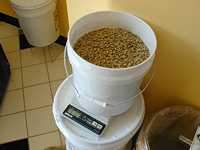 |
The roasting
process begins by weighing green beans. The quantity of beans introduced
into the roaster impacts the roasting time. Our Roastmaster has spent
many hours testing and tasting the roasted product for flavor and
smoothness. Once the roasting method has been optimized for a particular
type of bean, it is recorded in the Roastmaster's Notebook. For consistency,
the same quantity of beans is used for each roasting cycle. |
 |
The roaster is
preheated, ready to accept the green beans. The roaster will cool
down about 30 to 40 degrees once the beans reach the roasting chamber. |
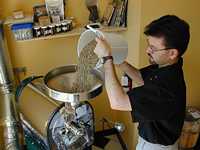 |
The measured
green beans are poured into the intake hopper. |
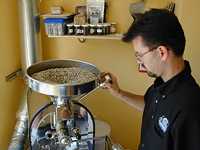 |
Beans are introduced
to the roasting chamber and the timer starts. The roasting chamber
is a rotating drum that tosses the beans constantly through the hot
inner atmosphere. From here on, the roast is monitored for temperature,
time, color and taste. |
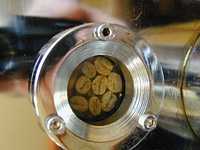 |
Roasting beans
are visible through a sight glass in the roaster. |
 |
During different
stages in the roast, the temperature is adjusted to follow the formula
achieved by the Roastmaster. |
 |
Careful notes
are kept and compared to previous roasting cycles. The flavor and
appearance of the product as well as conditions during roasting are
recorded. |
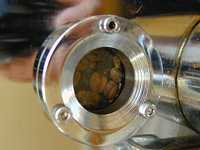 |
"First Crack"
occurs about half way through the roasting process and is an important
milestone. You can hear the outer shell of the coffee beans in the
roaster snapping. This indicates that the bean has begun caramelizing
and hardening. |
 |
A sample of the
bean is taken from the roasting chamber. The bean is evaluated for
color, smell and taste. |
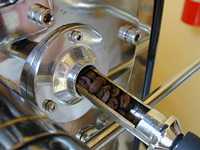 |
Further into
the roasting process, the "Second Crack" occurs. At this
point, a sample is taken every few seconds as the bean is now rapidly
changing. Beans may be compared to a previous roast considered "ideal"
for that variety. It is here that the degree of roast is determined,
whether it be medium, dark, french or espresso. |
 |
Here is where
the experience of the Roastmaster becomes important. The sound and
smell of the beans in the roasting chamber are indications of what
the beans are doing. The difference between a good and a bad roast
is only a few seconds of roasting time. At the moment of perfection,
the beans are released from the roasting chamber into the air cooler. |
 |
Since the beans
are very hot, they will continue to caramelize and change unless the
roasting process is stopped by cooling. The air cooler stirs the beans
and draws air through them with a powerful blower under the cooling
chamber. The cooling process may take about 10 or 15 minutes. |
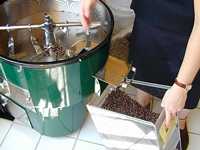 |
The cooled beans
are then placed in bins ready for use directly in our in-store brewers
or for our customers to purchase and take home. Our roasting capacity
is 1,000 pounds of finished coffee per week, enough to supply 50 large
restaurants plus our own retail operations. |














